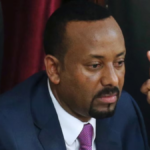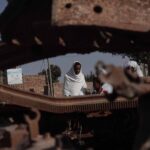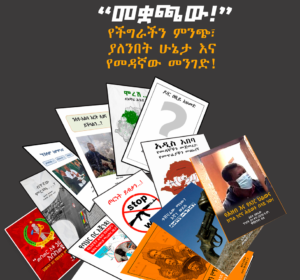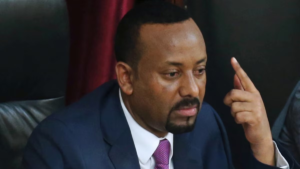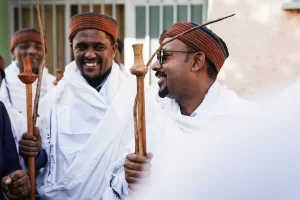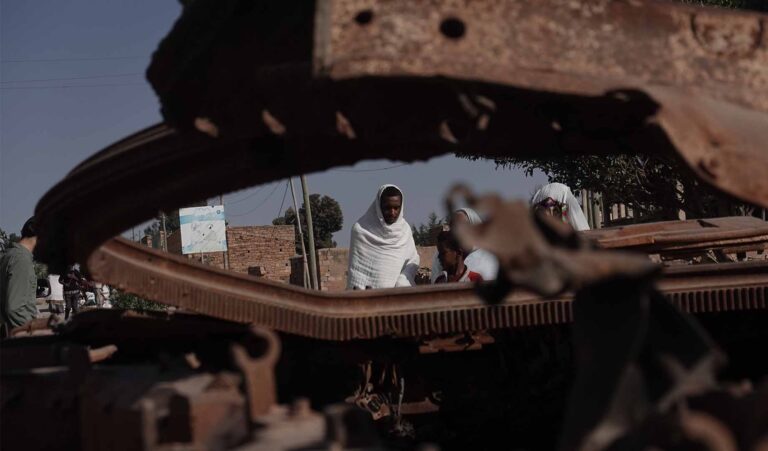By: Dhugaa Waqwayyaa. (Dhugaa is a member of the Oromia Senior Prosperity Party and Caffee Oromia, who wishes to remain anonymous due to security concerns)
Prime Minister Abiy Ahmed’s rise to power was met with widespread optimism and hope domestically and internationally. His early reform initiatives, such as the release of political prisoners and reconciliatory tone to mend relations with opposition groups, heralded a new beginning for a country long plagued by political turmoil and economic hardship. Making peace with Eritrea earned him global acclaim, culminating in winning the Nobel Peace Prize.
No sooner had Abiy received the award than his leadership began exhibiting authoritarian tendencies. Leading opposition parties were marginalized and eliminated, and potential opposition voices were silenced. Rather than fostering unity, his approach intensified divisions within the nation, plunging Ethiopia into a cycle of conflict and unrest.
This article traces the evolution of his administration and examines the consequences of his actions, aiming to unpack the complex political dynamics under Abiy’s rule. Furthermore, it aims to analyze potential future trajectories for Ethiopia amid the challenges posed by his leadership style and the prevailing internal strife.
The Quest for Absolute Power: Abiy’s Calculated Maneuvers
Throughout his tenure, Abiy has pursued a strategy aimed at consolidating power through various tactics, including alliance-building, repression, and exploitation of ethnic and religious cleavages. His overarching goal has been to establish himself as Ethiopia’s absolute leader, a quest marked by a series of calculated moves and power plays. In his endeavor to install himself as the sole power in the country, Abiy co-opted influential figures in political and religious institutions in Ethiopia, cutting them from their support bases and turning them into his mouthpiece. Examples of influential figures reduced to surrogates include Daniel Kibret from Orthodox church, Birhanu Nega of the Ethiopian Citizens for Social Justice (EZEMA), Belete Molla, the founder of National Movement of Amhara (NMA), and Lencho Bati of the Oromo Democratic Front (ODF). Abiy also neutralized institutions that have independent constituencies. He paralyzed the Orthodox church in the name of reconciliation —a church with immense influence in Ethiopia because of its historical role—by bringing home the dissenting faction of the church from overseas. Abiy also deracinated the member parties of the now-defunct Ethiopian Peoples’ Revolutionary Democratic Forces (EPRDF) coalition from their political bases by forming the Prosperity Party.
In the early stages, the Prosperity Party was fractious, riven by divergent visions and internal discord. Tensions between party members from different ethnic groups, such as the Somali and Afar, or the Amhara and Oromia, were palpable, reflecting a lack of cohesion and shared purpose. However, Abiy gradually exerted his authority, systematically eliminating dissenting voices and tightening control.
One notable figure to challenge Abiy’s authority was Lemma Megeresa, who was removed from the political scene and banished to Rome as an employee of the World Food Program. Another is Gedu Andargachew, who served in various positions fairly obsequiously before he was finally eased out of government unceremoniously. Recently, Taye Dendea, the former State Minister for Peace, publicly criticized the prime minister for his inexplicable propensity to sustain conflict and willingness to taint his hands with the blood of innocents. He was subsequently dragged out of his residence and remains imprisoned for the past two months without trial. His family was evicted from their government-provided residence. Finally, Abiy sacked his longtime deputy, Demeke Mekonnen, and replaced him with a more obsequious sycophant. In this way, Abiy has now asserted unchallenged control over the Prosperity Party.
The opacity of Abiy’s decision-making process was evident in his unilateral agreement with the President of Somaliland, which caught many within his party and government off guard. This episode underscored the dominance of Abiy within the party, where his word is law, and dissent is swiftly quashed.
Abiy’s skill at navigating the labyrinthine Ethiopian political culture is evident in his effortless moves of switching allegiances multiple times throughout his tenure. His once-cozy relationship with the Amhara elite, which he utilized against the Tigrayans, has now become strained. His tactical alliance with Eritrea, which hemmed in Tigray for four years, has now transformed into a contest of designating each other as the mortal enemy of the state.
Abiy’s leadership is characterized by manipulation, coercion, and a pattern of deceit, evident in both major decisions and daily actions. His authored work, “Erekabena Menber,” glorifies treachery, further reinforcing his reputation as a deceitful leader. Additionally, his erratic behavior and delusional claims, including assertions of divine appointment and grandiose visions of Ethiopia becoming a global superpower by 2050, contribute to a sense of uncertainty and unease among his inner circle, undermining trust in his leadership.
Since assuming power, Abiy has behaved more like a king than a prime minister, focusing on grandiose projects rather than accountability. His lavish office, palace renovations, extravagant parks, and parking lots in Addis Ababa were meant to attract investment and tourists but failed to address real needs or create jobs. Abiy’s refusal to disclose funding sources and insistence on only discussing approved parliamentary funds have further eroded trust. Projects like Entoto Park, Friendship Park, and Unity Park, as well as the construction of a new palace estimated at 15 billion dollars, raise concerns about their practicality and economic impact, especially considering Ethiopia’s financial challenges. Suspicions linger about the funding sources, including allegations of massive printing, with potential implications of runaway inflation.
The Cost of Abiy’s Interminable Wars
Conflict rather than peace covers the most extended period of Ethiopia’s history. The death toll of the conflict during the last five years of Abiy’s rule surpasses the casualties of the wars of the previous five centuries. According to a study conducted by Addis Ababa University Over five thousand (5000) conflicts were recorded in the last five years, resulting in the loss of 1.5 million lives. These numbers far exceed the combined total casualties in the wars with Italy, Somalia, and Eritrea and the prolonged civil war with Eritrea and Tigray, which are considered some of the most devastating conflicts in modern Ethiopian history.
The destruction caused by these conflicts is also unprecedented. For example, in Tigray alone, the war has reportedly caused over $80 billion in property damage. Given the yet-to-be-calculated amount of the ongoing destruction in Amhara and Oromia, it is clear that Abiy’s leadership has resulted in unparalleled devastation. Despite these grim realities, the Ethiopian prime minister has shockingly retained his Nobel Peace Prize.
The ongoing conflicts in Ethiopia have inflicted profound and multifaceted ramifications, extending deeply into the nation’s economic landscape and the welfare of its citizens. Oromia and Amhara, the focal points of these conflicts, have witnessed the diversion of critical resources towards war efforts. This diversion has resulted in a stark decline in agricultural production, particularly in the historically fertile areas like Wollega and Gojam, now grappling with famine and food shortages. Evincing a deepening humanitarian crisis, more than 30 million people face food insecurity, and Tigray and Amhara are experiencing famine.
Urban centers, notably the capital, Addis Ababa, are grappling with the harsh realities of heightened hunger and economic hardship. As essential food items become increasingly unaffordable, residents face dire circumstances, with many forced into precarious activities such as prostitution and criminal activities to survive. The staggering unemployment rate soaring to over 37 percent in urban areas worsens the situation. Additionally, the uncontrolled rising inflation, fluctuating between 38 and 40 percent, has caused the economy to grind to a halt, amplifying the strain on households and businesses alike. The unfavorable macroeconomic conditions indicate urban communities’ dire economic predicament and the precursors of looming social and economic instability.
The deterioration of the economic outlook has resulted in a significant decline in Foreign Direct Investment (FDI) inflows. This decline is particularly pronounced in critical sectors like manufacturing, which had been crucial for generating employment opportunities and export revenue in the last decade. Since 2020, the sector has seen only diminishing investments damaged by the closure of vital markets such as AGOA. Adding to the sector’s woes are the thousands of industries forced to shutter their operations due to foreign currency shortages and burdensome tax policies imposed by the government.
Adding to the complexity of these challenges is the acute shortage of foreign currency, with the government having only a few days, not months, of hard currency reserves. The erosion of savings exacerbates these woes as disillusionment occurs among citizens who once harbored dreams of homeownership through government-backed initiatives. With the Birr facing relentless devaluation against the dollar, the allure of saving diminishes, intensifying the economic strain. It’s noteworthy that when Abiy came to power, the official exchange rate of the dollar to the birr, which stood at twenty-seven, now hovers around birr fifty-seven. The unofficial black-market rate is currently around birr 120 and rising.
Many criticize the government for failing to adequately support students over the past two years, as only slightly over 3 percent of the 1.6 million students who took the tertiary level entrance exams passed. Consequently, there is a growing trend of students being directed towards military service as their primary option, as other employment opportunities are closed off.
Fueled by ongoing conflicts, insecurity undermines investment prospects, with Addis Ababa becoming the sole refuge for investors experiencing widespread closures of factories and businesses elsewhere. To make matters worse, corruption permeates all levels of government, with some decrying the situation as outright looting compared to past eras.
How Abiy Maintains Power
Prime Minister Abiy’s approach to maintaining power hinges on a multifaceted strategy aimed at grassroots division and centralized control. At the grassroots level, his administration perpetuates division among ethnic, religious, and social groups to thwart any unified opposition. To this end, he even resorted to forming a killing squad called “Koree Nageenyaa”, as reported by a Reuters investigation focused on the Oromia region. Concurrently, Abiy pursues efforts to consolidate power at higher levels through coercion or cooption, leading to further fragmentation throughout the country.
There are mounting concerns that the prime minister might divide the larger regions like Oromia, Amhara, and Somali into smaller administrative units to solidify his grip on power. There is public anxiety that Abiy would resort to exploiting internal conflicts and fragmented power in the regional governments and pave the way for constitutional changes to consolidate his authority. These developments underscore Ethiopia’s precarious position, grappling with challenges that threaten its stability and unity.
As Prime Minister Abiy prioritizes protecting his power, concerns for citizens’ well-being and government functions, including security, service delivery, and governance, have taken a backseat. His tenure has seen significant cuts to vital sectors, with 100,000 jobs dissolved in health and agriculture extension sectors since coming to power. Additionally, subsidies for agricultural inputs and fuel have been halted, impeding progress in crucial areas of development.
Investment in infrastructure and key projects has stagnated, with no new universities or factories constructed under Abiy’s leadership. Instead, resources have been redirected to bolstering security forces and funding the war effort, neglecting initiatives that could enhance employment opportunities and improve living conditions for the populace.
Abiy employs a dual strategy of financial incentives and intimidation to maintain his grip on power. Government resources from significant corporations and taxes are channeled into building and reinforcing the security sectors, including defense and intelligence agencies. Meanwhile, undisclosed benefits and incentives are provided to a vast network of security personnel, ensuring their loyalty through material gain.
Abiy’s frequent reshuffling of officials within ministries appears more about consolidating his own power. The alarming frequency with which key positions, such as Chief of Staff, Intelligence Head, Information Network Security Agency Head, Federal Police Commander, Minister of Justice, Minister of Foreign Affairs, and Minister of Defense, have been shuffled—often four to five times within the past five years—reflects a concerning pattern of instability rather than effective governance. Moreover, the repeated turnover of regional presidents, exemplified by the Amhara region’s six changes in leadership, indicates a troubling trend toward centralized control and disregard for established democratic processes. In essence, Prime Minister Abiy’s strategy of incessant reshuffling serves as a tool for perpetuating his own grip on power.
Furthermore, investors are coerced into contributing to the ruling party and supporting military officials’ households, extending beyond the benefits provided by the government. This strategy incentivizes compliance and ensures the allegiance of security forces, even if they do not ideologically align with the government.
Finally, Abiy opposes independent investigations into the massacres and war crimes committed during the Tigray war or in the Oromia region. Instead, he seeks to maintain control over the government narrative, perpetuating divisions between ethnic groups such as the Tigray and Amhara, Amhara and Oromos, and fueling hatred among them.
Potential Scenarios of Ethiopia’s Future
Scenario 1: Abiy’s Consolidating Power
Prime Minister Abiy would intensify efforts to divide and weaken opposition groups to maintain his grip on power. He would exploit existing tensions between the Amhara and Tigrayans by manipulating the territories of Raya, Wolkait, Humera, and Tsegede and the atrocities committed during the Tigray war. This could further fracture these communities, making schemes of divide and rule easier. Similarly, he would stoke fear among the Oromo population by portraying the Amhara as a threat, thereby consolidating support from the Oromos who fear a return to previous oppressive regimes.
Abiy’s administration could also exacerbate instability, insecurity, and poverty in other regions through corrupt practices, ensuring that people are preoccupied with survival rather than political activism. Continuous inter-regional and intra-regional conflicts would distract from national issues, allowing Abiy to exercise power without meaningful opposition.
Abiy may pursue championing grand agendas to bolster his image, such as securing access to the sea. By leveraging the agreement with Somaliland, he could gradually gain access to the sea and establish control over the hinterland despite potential opposition from Somaliland and Somalia. This strategy could serve as a distraction while Abiy pursues other objectives, such as engaging in a war with Eritrea to secure permanent access to the sea, resulting in never-ending conflict with Eritrea.
Scenario 2: Northern Alliance Emerges or a renewed conflict in Tigray
The Pretoria Cessation of Hostilities Agreement (CoHA) signed on November 3, 2022, temporarily silenced the guns in Ethiopia between the government and the TPLF. However, the failure to fulfill commitments by Abiy’s government, such as releasing funds and facilitating the return of displaced persons, has deepened mistrust among Tigrayans. As a result, Tigray now faces dire circumstances, with 90% of the population in need of food aid, one out of six persons displaced, and over 52% of arable land occupied by Eritrea or Amhara forces.
This failure has fractured Tigray’s leadership, eroding the unity forged during the initial conflict. Tigrayans are now at a critical juncture, torn between accepting their plight or resisting further. Tensions between the federal government and Tigray authorities suggest that another conflict is imminent.
Alternatively, a coalition of opposition forces from Tigray and Amhara could unite to overthrow Abiy’s government. However, past atrocities and territorial disputes make forming a strategic alliance challenging. Tigrayan forces may consider an agreement with Eritrea to secure their rear during potential conflict and address internal divisions within Tigray. This scenario becomes more likely if the federal government fails to uphold the Pretoria agreement and humanitarian conditions in Tigray do not improve.
Scenario 3: Escalating Ethnic Strife in Ethiopia
The two most populous regions, Oromia and Amhara, are engulfed in unrest, with armed groups like the Oromo Liberation Army (OLA) and the Fano of Amhara exerting significant influence, making governance challenging. Movement of people and goods is severely restricted, worsening economic hardships. Meanwhile, the Ethiopian military, deployed primarily in these regions, struggles with purpose and potential division along ethnic lines. The Ethiopian military faces division along ethnic lines, deploying Oromo troops into Amhara and vice versa, heightening tensions. As authority collapses in Amhara and Oromia, a mass exodus towards Addis Ababa looms, threatening security and diverting attention from external threats. The OLA and Fano may escalate conflict to the capital, heightening the risk of genocidal conflict and humanitarian crisis between the Amhara and Oromo communities.
Scenario 4: Revolt within the ruling party
Another unlikely and probably farfetched scenario is for Abiy to face the fate of his predecessor, Hailemariam Dessalegn. Abiy has worked from the outset to minimize the possibility of this occurrence by merging EPRDF member parties into a single party. However, mounting economic challenges and security concerns in Ethiopia and the country’s inability to deliver financial incentives for top party members have led some within the Prosperity Party to consider ousting the prime minister. Despite enjoying unparalleled power within the government and the ruling party, no ideological bond holds the party members together; instead, the pursuit of public resources and fear of reprisals from the security apparatus maintain cohesion within his government and party. With economic challenges intensifying, Abiy may struggle to find sufficient rent to satisfy the insatiable desires of officials or bolster the security apparatus to compel compliance. As the transition in leadership from Hailemariam to Abiy demonstrated, a change in leadership offers no guarantee that the new leader will steer the country toward prosperity and security.


